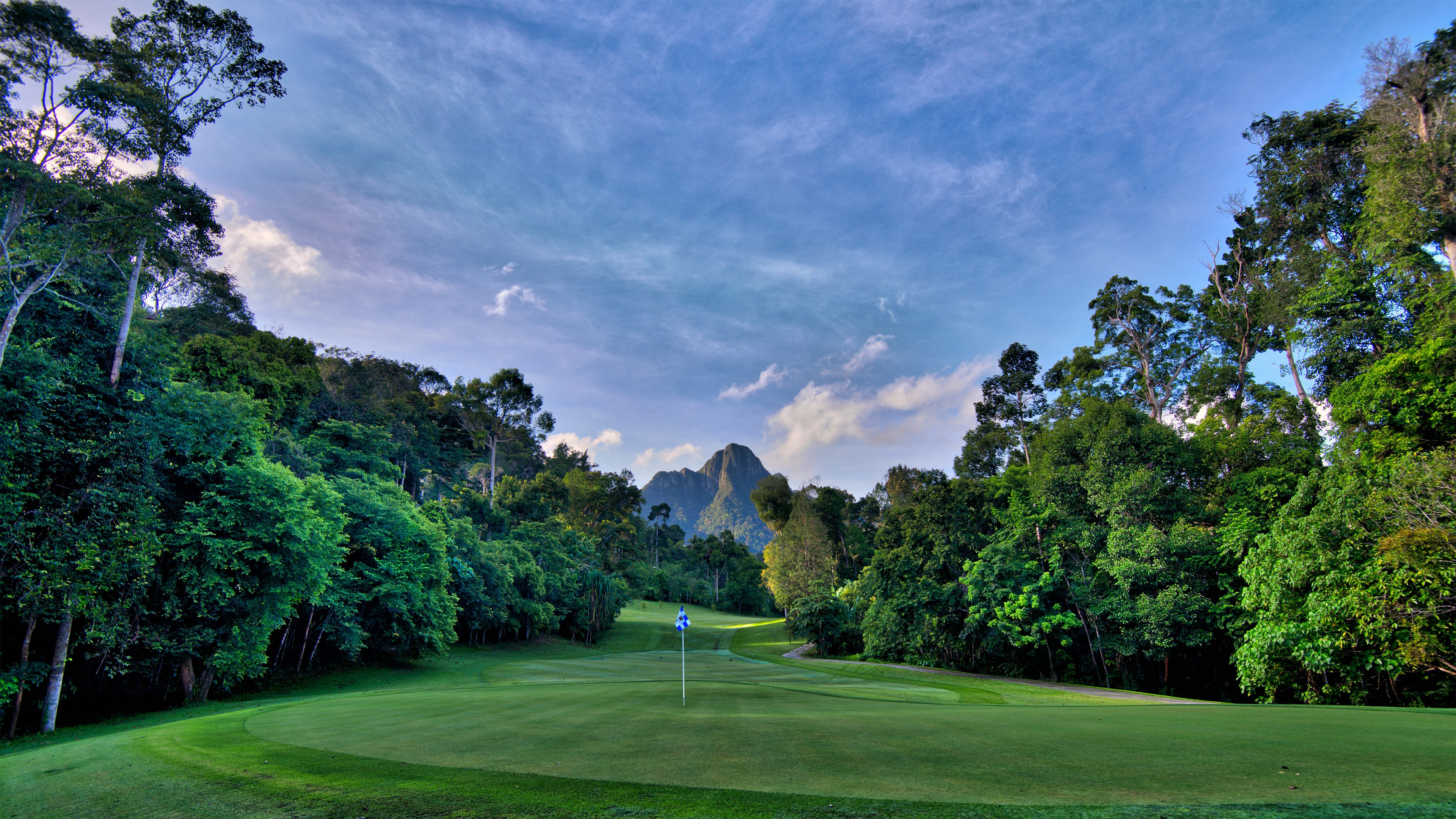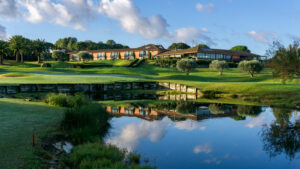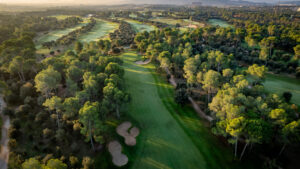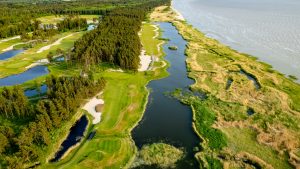“Where are all the bunkers? We’re on the fourth hole, and I haven’t seen a single one”, my opponent wondered.
As we played on we found no bunkers on the fifth hole either. Or the sixth, or seventh. In fact we found not a single bunker on the entire course, unless you count the beach lining the 17th hole.
After our round, we found the answer: There are no bunkers at all at the Els Club in Teluk Datai, because Ernie Els decided it was a bad idea from a maintenance standpoint. It is simply too hard to keep the bunkers from washing away during the monsoon season. Probably a wise decision, but no doubt a controversial one.
We were on the island of Langkawi in Malaysia to try out a course that has risen in the world rankings since Ernie Els redesigned in and blessed it with his name. The course was originally designed by Ted Parslow and opened in 1992, but it closed for renovation and redesign in 2011. At the very end of 2014, it reopened, now with Ernie’s name attached, as the Els Club Teluk Datai.

The atmosphere at the club is one of laid-back luxury. The restaurant is covered but basically outdoors, luxurious yet relaxed. The service is attentive yet unobtrusive. The caddies are professional with nice uniforms. The pro shop is fully stocked with Ernie Els logo gear, at steep prices though.
In the 2016-17 Golf Digest Top 100 courses Teluk Datai came in at number 83, ahead of courses like Bandon Dunes, Sunningdale, Jumeirah Estates and the Gary Player Course at Sun City. Does the course live up to such a lofty position? We set out to find out.
The course
Fairways are wide on the course, and you are strongly recommended to stay in the short grass, since the alternative is, well, jungle. With plenty of large trees lining the fairway, and sometimes overhanging, playing strategically is more important than going long on every hole. Stray too far offline, and your ball might be stolen by one of the resident macaques or dusky leaf monkeys.
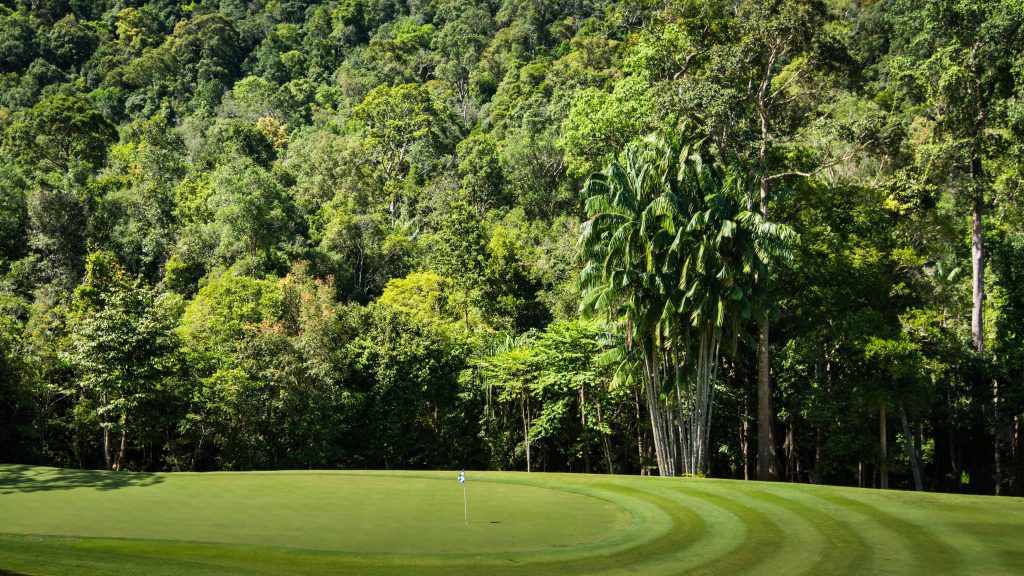
With no bunkers on the course, grass swales and slopes protect the greens. Not exactly the same, but you can still get in trouble.
To the north is the Andaman Sea, and you first reach it on the par three 5th. This is the beginning of a challenging and beautiful stretch of holes. Hole 6 looks easy on paper, but the pond right in front of the green makes for a challenging approach, quite a long one unless you are a big hitter. Holes 7 and 8 are back to back par fives, one with a green jutting out into the sea, the next a dogleg left with water in play on both the tee shot and the approach. Hole 8 was my favorite on the course.
The back nine takes you away from the sea and back into the forest, but starting on the 15th you work your way back to the coast. The tricky 16th ends at the coast, and now you are ready for the signature 17th hole, a short par three along the coast. At 153 yards from the men’s tee, it shouldn’t be difficult, but with water on the right and big runoff areas to the left of the green, it is one of the trickier but at the same time maybe the most beautiful hole on the course.










All in all the course runs 6760 yards from the black tees, 6449 from the men’s silver tees. The holes are the same par for men and women, but the handicap index is different for women, making match play a bit of a math challenge.
Overall the course is nice for players of all handicaps and abilities. With the Ernie Els redesign, the undergrowth among the trees next to the fairway has been cleared, so more often than not you’ll find your ball, as opposed to earlier when missing the fairway meant a lost ball. The complete lack of bunkers make a few holes a bit too easy though. But who doesn’t like to score well?
So does the course live up to its ranking? I think it depends on how much of a traditionalist you are. If you are bothered by the lack of bunkers you’ll have a hard time appreciating the course, but if you can ignore that “detail” I think the course deserves its ranking. Rankings are of course all very subjective. I’ve played higher-ranked courses that I didn’t think were nearly as good, and I’ve played courses with lower ranks that I think were better, but all in all the ranking is not too far off.
The only way for you to know how the course ranks in your book is to come to Teluk Datai and decide for yourself. I think you should.
Mountain climbing
In the afternoon we went to explore Gunung Mat Chinchang. Gunung in Malay means “mountain”, and Mat Chinchang is one of the more interesting ones, especially if you are into geology. Mat Chinchang was the very first part of Southeast Asia to rise from the sea after the Rodinia era, so when you play Teluk Datai you are actually standing on the very oldest part of the subcontinent, more than half a billion years old. I wonder if Ernie was aware of this when he reshaped the land?
Because of this geological significance the entire island of Langkawi is now recognized as a UNESCO Geopark, and is protected as such. With this designation geotourism is of growing importance for Langkawi and that is a good thing, since it emphasizes sustainable tourism and conservation.
To explore the mountain, we donned out mountaineering gear, loaded our backpacks with freeze-dried food, and filled our water bottles…. just kidding, we didn’t. We took the easy way up with the Langkawi SkyCab. Easy, unless you are afraid of heights. The 2.2km ride has the steepest elevation in the world for a cable car at 42°, and the longest free-span of over 900 meters. You sometimes ride almost 100 meters above the canopy, so it’s not for the faint of heart, especially if you ride in one of the glass bottom gondolas.
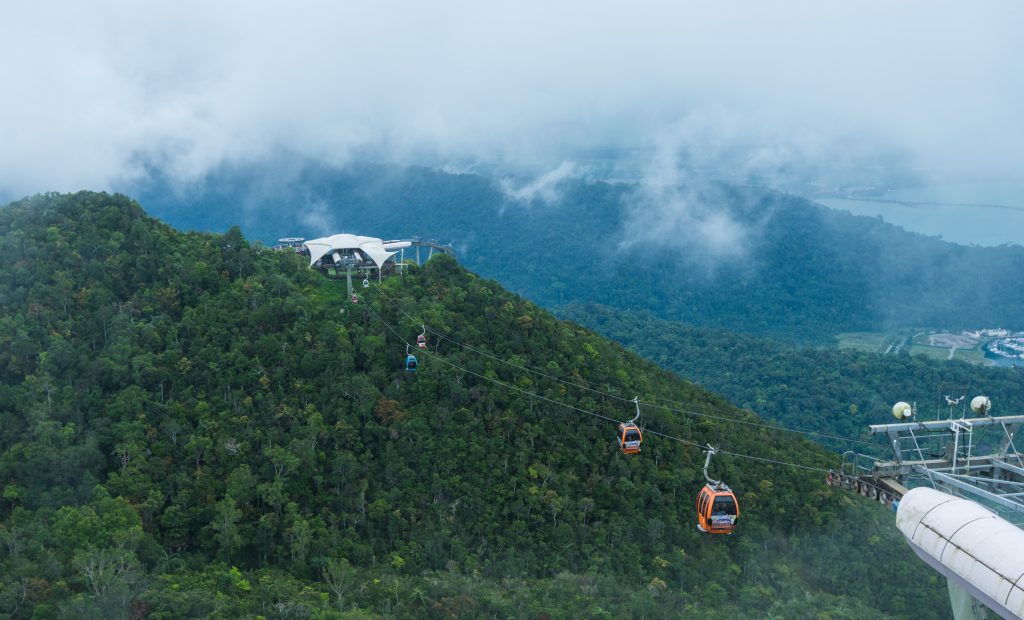
Once you reach the top you are rewarded with some stunning views of Langkawi. If you have managed to calm your nerves you can also walk across the Sky Bridge, a 125-meter walkway supported by cables and a single pylon, connecting two peaks of Gunung Mat Chinchang. The Sky Bridge holds another world record as the longest bridge supported by a single pylon. If you dare, you will be rewarded with some fabulous views of the rainforest below, and the walk is also good practice if you later intend to walk across the other famous Malaysian sky bridge, the one connecting the two Petronas Towers in Kuala Lumpur.
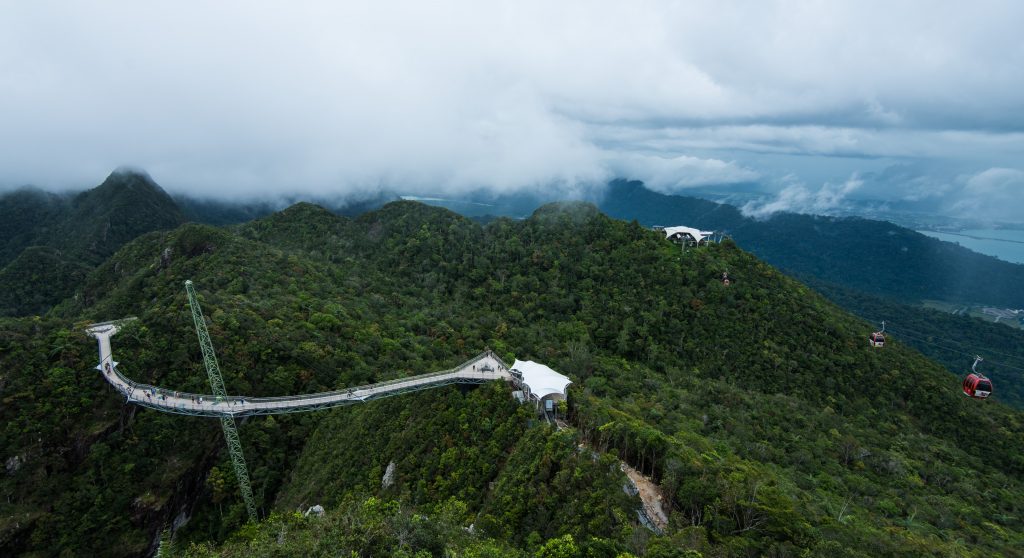
With all the excitement and wonderful views it is easy to miss the geology exhibit at the top of the stairs from the gondola terminal, but try to make some time for it. It’ll make you understand what you are standing on.
Gunung number two
The next morning we headed for another Gunung, this time the highest mountain on the island, Gunung Raya. We were not out to climb it though. Our goal was the golf club in the foothills, the Gunung Raya Golf Club.
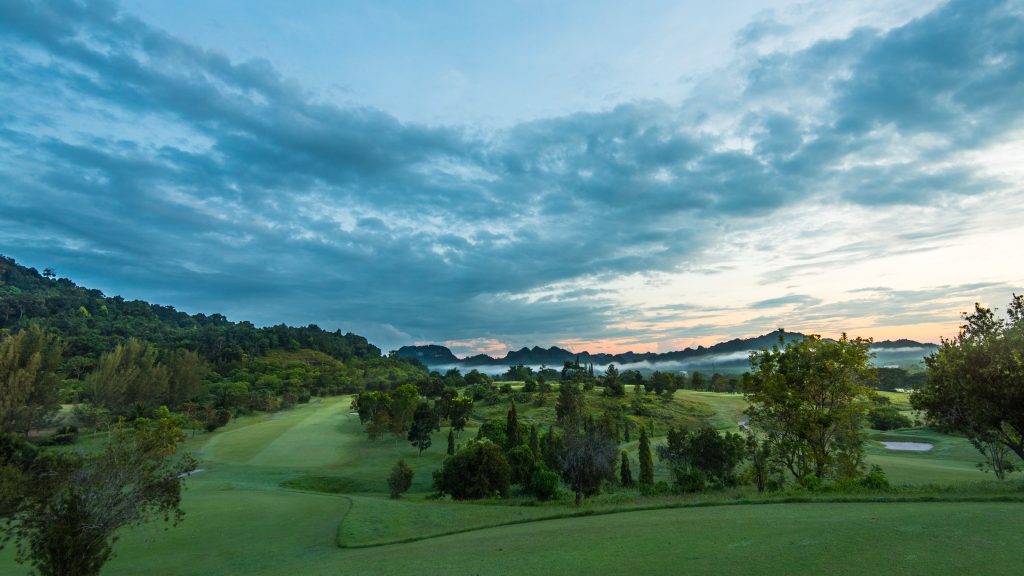
We arrived just before sunrise and were treated to some unique views. When you stand on the first tee you are looking out over what appears to be an endless jungle, only interrupted by the occasional fairway. The mountainous landscape offers some truly stunning panoramas, and architect Max Wexler has made perfect use of the natural landscape, with plenty of elevated tees and greens.
The first nine offers more spectacular views, starting right on the first tee. The fairways often appear to be quite narrow, but they usually open up in the areas where your drive will (should) land, so the course is not overly difficult. The rough is covered in dense Bermuda grass though, so it is wise to stay “in the pretty”. The same goes for the foregreens. Any approach shot short of the green tends to just stop dead, so you need to play a high game. The greens are fairly hard, but not mowed too short, so it is quite possible to stop your ball.
The second nine are on lower, more level land. The 10th hole, a par five, is the signature hole. Starting high at the clubhouse, it doglegs right, running next to a lake. Any straight drive tends to end up in the lake, so unless you can hit a power fade, avoid the driver. The green is nicely protected by bunkers, one of which has a palm tree right in the middle. A demanding but beautiful hole.
The eleventh, a par three, is the best of all the par three holes. Also running along the lake, it demands some precision to hit the green surrounded by water on one side and bunkers on the other. Holes 12, 13, and 14 are also quite nice.








Overall, the course is a bit underrated. We found the design both interesting and challenging, well worth visiting more than once. The quality was average, except for the greens that could use some work, and some of the bunkers that had some water damage from the monsoon rains (Ernie was probably right in omitting bunkers). Nothing that couldn’t be easily fixed, but to get top rating it would have to be worked on.
The clubhouse has all you need. A small but well-stocked pro shop, a nice locker room, and an excellent small restaurant with a terrace overlooking the course. The food was very good and prepared with some tender loving care, almost like a home-cooked meal.
With all the hoopla around The Els Club, the Gunung Raya Golf Club has been somewhat forgotten, undeservedly so. It is a fine venue, holding up very well to its more famous competition. We definitely recommend that you make time to play it.
Exploring Langkawi
Langkawi was long a sleepy backwater, but in 1987 the island was granted tax-free status, and this was the start of a tourist boom. Luckily the island has not been overdeveloped, and you just have to stray a small distance from the main tourist beaches to find genuine Malaysian villages where the locals go about their life as they always have.
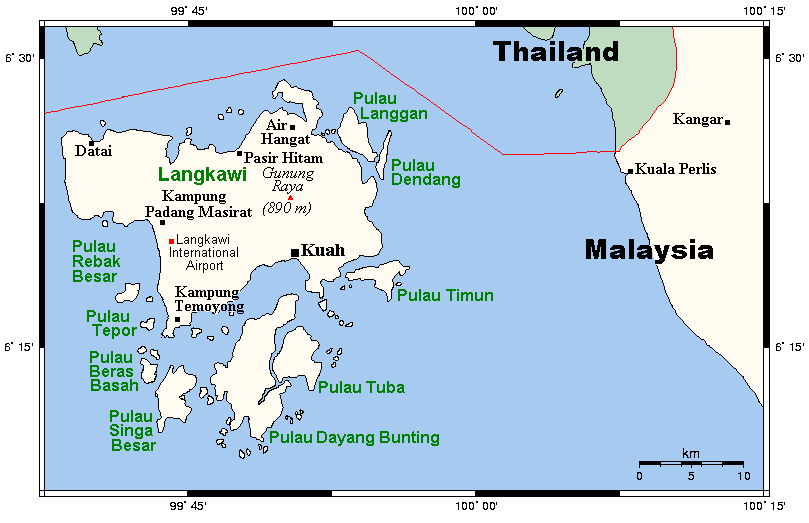
Maybe because of this, Langkawi is very popular with families and couples, pretty laid back. You can enjoy a day at the beach without being harassed by a string of salesmen hawking cheap souvenirs. Not at all like overexploited tourist towns like Phuket and Koh Samui in nearby Thailand where life can be overbearingly hectic. However if you do want to shop, you can enjoy good prices on most goods due to the island’s tax free status. A good place to go is the Langkawi Parade Megamall in the main town of Kuah.
Water sports are popular, as are excursions to some of the other 98 islands that make up the province of Langkawi. Since the island is focusing on ecotourism there are also many nature excursions to choose from. Or simply relax after golf and enjoy a massage and spa treatment, followed by dinner at one of the many excellent local restaurants.
It‘s simply hard to go wrong in Langkawi.
